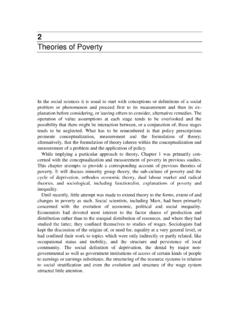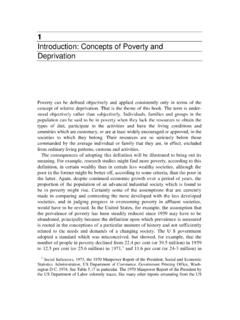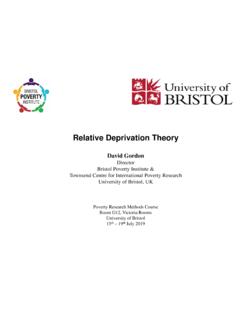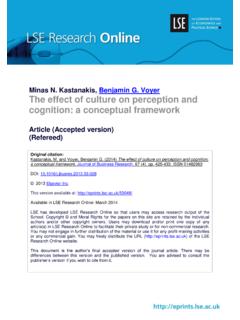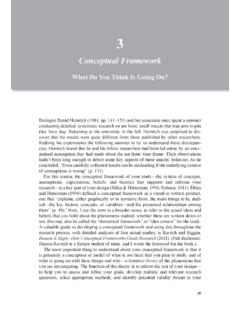Transcription of Mental Health, Poverty and Social Exclusion
1 conceptual note Mental health , Poverty and Social Exclusion Sarah Payne, University of Bristol, December 2012. Introduction Various studies have suggested that there is a relationship between Poverty , and Social Exclusion , and Mental health problems, but this is complex, both in terms of how we might measure poor Mental health , and in how we might assess the direction of causality: does Poverty , or Social Exclusion , cause poor Mental health , or does poor Mental health lead to Poverty and Social Exclusion ? Of course the answers to this question are not straightforward. Firstly it is likely that the interaction between Poverty , Social Exclusion and experiences of poor Mental health is two way rather than one causing the other. Secondly, issues of timing are important Mental health problems are often chronic and persistent, and the ways in which they impact on experiences of Poverty or Exclusion can vary over time for individuals, in association with their employment status for example, or with household characteristics and circumstances.
2 The association between Poverty and Social Exclusion and Mental health Poverty Poverty impacts on Mental well-being in various ways. Research focusing on individual experiences has found associations between symptoms of common Mental health disorders such as depression and anxiety and Poverty (Weich and Lewis, 1998a; Butterworth et al. 2009; Jenkins et al. 2008). Other studies have used area level analysis to explore the association between Poverty and Mental health . These analyses have found higher levels of hospital admissions, out-patient use for Mental health services and suicide and parasuicide in poorer areas (Gunnell et al. 1995; Rehkopf and Buka 2006). With area level studies a degree of caution is needed, for two reasons. The first is the question of the direction of causality and drift': are people who are experiencing poor Mental health more likely to live in impoverished areas, perhaps moving to these localities after becoming ill due to loss of income and housing, for example?
3 The second caution often referred to as the ecological fallacy' reflects the uncertainty around the association. While rates of treated Mental illness or suicide may be higher in poorer areas, these are rates per head of population rather than descriptions of individual circumstances. We cannot tell, from ecological studies, if the people who were diagnosed as having poor Mental health , or those who committed suicide, were themselves poor, we only know that they live or lived in a poor area. 1. Why might there be a relationship between Poverty and poor Mental health . A range of factors are involved, including the effects of illness on income and living circumstances. For example, if poor Mental health means an individual's earning capacity is reduced, through the loss of paid work or a reduction in the level of work, then Poverty may be a consequence of Mental illness (Lorant et al. 2007). However, poor Mental health may in turn arise out of the effects of being poor - the stress of managing on a low income, for example, or of living in poor quality housing, or trying to provide for children.
4 Other effects of Poverty which might lead to a deterioration in Mental well-being include low self-esteem because of employment status, and decreased opportunities for positive self-esteem without a formal work role, or the stigma associated with welfare receipt and discrimination. Again, timing of the association is complex: one study by Weich and Lewis (1998b), for example, found that Poverty and unemployment were both associated with the persistence of poor Mental health , but not the onset of illness. These influences can also be inter-related for example stigma associated with being unemployed or claiming benefit may be exacerbated for those also affected by the stigma which often attaches to Mental illness (Sayce 1998). Social Exclusion Until relatively recently there have been fewer studies of the relationship between Social Exclusion and Mental health difficulties (Morgan et al. 2007; Mezey et al. 2012) However, new research reveals an increased risk of poor Mental health and suicide among groups experiencing different forms of Social Exclusion , including for example unemployment and poor Social capital (Morgan et al.)
5 2007; Whitley et al. 1999). Mental health policy under the Labour government between1997 and 2010 focused on Social Exclusion as a consequence of Mental health difficulties rather than as a cause (SEU 2004) and this association is borne out by research on the impact of discrimination, unfair detention, stigma and constructions of difference' (Morgan et al. 2007). Sayce and Curran (2007) for example argue that people with Mental health problems are excluded from consuming health services, such as health promotion and health improvement programmes that are available to others, leading to unequal health outcomes and increased mortality among these populations. Similarly people with Mental health problems experience Exclusion as a result of their low employment rates and inequalities in the chance to contribute' (Sayce and Curran 2007:40). However, Social Exclusion can also lead to an increase in the risk of poor Mental health through isolation, loneliness and low levels of self-esteem, for example, while Social capital can act as a protective factor (Mezey et al.
6 2012; Stafford et al. 2008). How are we addressing Mental health in the Poverty and Social Exclusion Survey? Often data on ill- health is collected using either self-report measurements in which individuals assess their health status, or figures based on the use of health care and illness diagnosed by health professionals. There are difficulties with both these measures for physical health conditions, but these difficulties are greater for Mental health . Self-reported data for Mental health problems will reflect various interpretations of what constitutes Mental ill- health , and also be affected by the stigma that is associated with Mental illness. Similarly research suggests that some people with Mental health problems are less likely to seek health care men, for example, under-consult for depression and anxiety, while Mental illness is not always appropriately diagnosed by health care professionals (Kilmartin 2005). Given the complexity of measuring Mental illness on the basis of self-report or treatment data, the PSE survey has used a well-validated instrument, the General health 2.
7 Questionnaire (GHQ) 12 which will enable comparison with findings from other research in the UK and elsewhere. The GHQ is widely used to indicate presence or absence of symptoms of what are often described as common Mental disorders' (CMDs). The GHQ12. is the shorter version of a longer format questionnaire, and is a self-complete questionnaire with 12 items covering symptoms of poor Mental health . Each question offers 4 possible answers, such as not at all' no more than usual', rather more than usual' and much more than usual'. Answers vary slightly according to the wording of each question. Answers are rated in a binary fashion in the example above the first two responses score 0 and the other two score 1. The lowest possible score for each respondent is 0 and the highest is 12. There are two options in relation to the cut-off point for scores which indicate the presence of common Mental disorders (CMD), and there are many examples of studies using each option. In the first option, a score of 0-2 indicates no CMD and 3+ is taken to indicate the presence of a CMD.
8 In the second system a score of 0-3 indicates no CMD and the cut-off is 4 or more for CMD. It is suggested that the cut-off point used should be determined by each study and may vary between countries to reflect cultural differences or other factors (Bell et al 2005). The health Survey for England has frequently used the GHQ12 (Robinson 2010) and analyses this data by respondent income levels and area deprivation. The health Survey for England uses a cut-off point of 4+ for CMD. The GHQ12 is not intended to identify psychotic illnesses and will not necessarily identify substance use problems, unless these are accompanied by anxiety and depression. It does not give the same level of result as more complex and longer survey instruments, such as the CIS-R (see below). For example, it has been estimated that the GHQ12 has around 70- 80% of the sensitivity and specificity of other longer instruments (Bell et al. 2005). However, it is relatively easy to administer in a self-complete section of a survey, is well validated and can be compared with other surveys in this field, which adds to its value in the PSE survey.
9 References Bell,T., Watson,M., Sharp, D., Lyons, I and Lewis, G. (2005) Factors associated with being a false positive on the General health Questionnaire. Social Psychiatry and Epidemiology 40: 402-407. Butterworth, P., Rodgers, B and Windsor, TD (2009) Financial hardship, socio-economic position and depression: results from the PATH Through Life Survey. Social Science and Medicine 69: 229-237. Gunnell, DJ, Peters T, Kammerling, RM and Brooks B (1995)Relation between parasuicide, suicide, psychiatric admissions, and socioeconomic deprivation. British Medical Journal 311(6999):226-30. Jenkins, R., D. Bhugra, P. Bebbington, T. Brugha, M. Farrell, J. Coid, T. Fryers, S. Weich, N. Singleton, and H. Meltzer. (2008) Debt, income and Mental disorder in the general population. Psychological Medicine 38(10):1485-93. Kilmartin, C. (2005) Depression in men: communication, diagnosis and therapy. The Journal of Men's health & Gender 2(1):95-99. Lorant, V, C Croux, S Weich, D Deli ge, J Mackenbach, and M Ansseau.
10 (2007) Depression and socio-economic risk factors: 7-year longitudinal population study. British Journal of Psychiatry 190(4):293-98. Morgan,C. Burns,T., Fitzpatrick,R, Pinfold,V and Priebe,S (2007) Social Exclusion and Mental health : conceptual and methodological review. British Journal of Psychiatry 191, 477- 483, 3. Mezey, G, White, S. Thachil, A., Berg, R Kallumparam,S. Nasiruddin, O., Wright, C and Killaspy. H (2012) Development and preliminary validation of a measure of Social inclusion for use in people with Mental health problems: The SInQUE. International Journal of Social Psychiatry. Rehkopf, DH., and Buka S L. (2006) The association between suicide and the socio- economic characteristics of geographical areas: a systematic Medicine 36(02):145-57. Robinson, C. (2010) Self-reported general health and psychosocial health . In Craig, R. and Hirani, V. (eds) health Survey for England 2009 Vol 1: health and lifestyles. Natcen and NHS The Information Centre Sayce, L. (1998) Stigma, discrimination and Social Exclusion : What's in a word?
